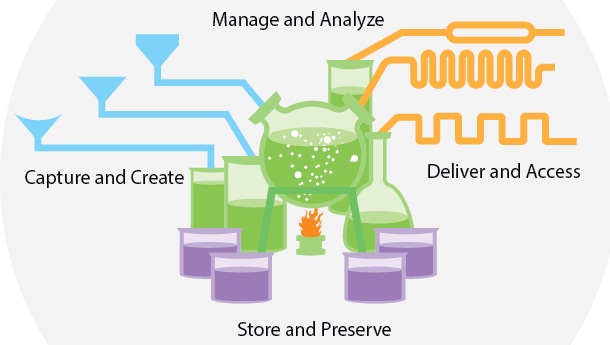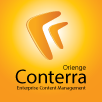How to Organize Your Informational Space
Every company, no matter if it is a small startup or a multinational corporation, faces the same challenge – surviving under heaps of documents and other corporate content. The documents both come from partners, regulators and other external organizations, and are created in the depths of the company. There are plenty of recipes for combatting the hydra of corporate information, but most of them just say, “Do an audit of existing documents, classify documents and compose retention policies”. Sounds good, but such recipes are too common and abstract to be somewhat useful. The main challenge is making up (inventing) your own principles of how to tidy up your documents.
Having your content organized will help you reach some meaningful aims:
- You can easily find any document. This means lower operational costs and better productivity.
- You can track a required document and tell who is working with it at this very moment. You can substantially reduce the number of lost documents.
- You can drastically reduce time you spend searching and retrieving documents. Besides, you can be sure that your document selection is complete. That can be critical when you respond a regulator or a shareholder request.
- You can considerably cut penalties caused by incompliance with regulators’ rules and requirements.
Content organization here means dividing corporate information into classes or groups. Classifying information is definitely a sort of art. Before your dive into the world of document classification, let’s take a look at some of the popular ideas and approaches.
Structured and Unstructured Content. One of the popular contemporary ideas is to divide all enterprise content into structured and unstructured heaps. While structured information is mostly presented as corporate data, the unstructured part is comprised of human readable (designed to be read by human beings) documents. According to the paradigm, structured data is mostly processed by ERP systems, while unstructured documents are chiefly stored in ECM systems. Actually, that is also too simple to be true. An advanced ECM system can process a good portion of structured data such as a list of concluded contracts and their obligations, a list of claims, an external organization databook. Another weakness of this approach is that the ratio of structured and unstructured content in an average company is 20:80. Eighty per cent of information is too much to be treated it as an indivisible heap.
Forrester Approach. An independent expert and researcher Forrester comes with a relatively new approach, according to which all corporate content can be divided into Business, Persuasive, Transactional and Foundational types. This is definitely a step forward and makes more sense than just dividing content into structured and unstructured. On the other hand, every group still comprises numerous document types. For example, all your website content, all letters you send to customers, all leaflets and marketing budgets are just persuasive content. If you put all this content together, the heap will still be unstructured, and it won’t help you to put your corporate content in order. However, defining the content type for a specific document may sometimes be confusing. The difference could be too speculative and vague. This approach is good in theory but hardly applicable in practice.
Documents and Records. Corporate information is traditionally classified into records and documents. It is also traditional to distinguish between document management and records management. Document management solves common tasks such as creating and approving drafts, and organizing collaborative environment for working on different documents. Not all documents stored in a DMS will be declared as records, but that doesn’t make them less valuable than records. Records management is very close to risk management. The aim of records management is to guarantee that all records which can be used to back up company’s position in arguments, audit or regulator’s actions are kept securely and can be retrieved within a set deadline.

As you see, dividing corporate content into records and documents is just the very first step. Both groups are too huge to manage them successfully. So you have to classify them into smaller groups. The official Orienge’s opinion is that records and documents should be classified in a different way. Let’s have a look at the conception.
An organization usually utilizes one records classification scheme. It is possible to have more than one records classification scheme, but all records keepers deal with the same schemes. Every scheme is approved by the records management authority and usually not changed within a year. All changes should also be approved. Every record receives an individual reference code, which is used to refer to the record in different registers, journals, lists and other documents. In rare cases, a record can have more than one code. It usually happens when there are two or more places in the organization where records are registered, for example, its headquarters and branch offices.
With documents, the situation is the opposite. Users form their own environment where they store documents. Here users organize documents for their own convenience: to simplify and boost search, to build workspace for a project. In the Conterra ECM system every user is enabled to create a personal folder structure. Folders can contain documents, jobs, tasks, folders and other system components. Actually, when you add a document to a particular folder, the document does not change its position in the repository. Instead, a new link to the document is created. That allows users to put multiple links to different folders, all of them referring to the same object. When you alter a document or its card, the result can be observed in every folder containing a link to this document.
You can also create folders that look exactly the same for all users. Meaning all users with the same access rights, of course. Though this structure is unique for the whole organization, it is not a records classification scheme; it is just another working space for collaboration.
Modern ECM systems can help users to organize their informational working space both for documents and for records, taking into account their differences. While records classification should be one and the same for the entire organization, document folder structure should be personal, for better users’ convenience.

